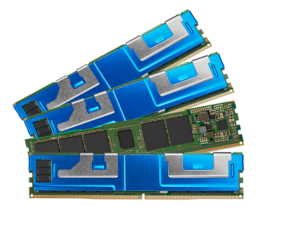


SSD is self-explanatory: it’s an implementation of 3D XPoint that can be consumed as ultra-low latency storage for Tier-0 workloads. Optane DC comes in two flavors: SSD and Persistent Memory, two different ways of consuming Optane DC. A schematic view of 3D XPoint Memory – Source: Intel Presentation Intel Optane DC Products Intel guarantees the media against any failures due to cell wear during the warranty time of its 3D XPoint devices, which implies that the media must be extremely durable. For comparison, both TLC and QLC 3D NAND are already beyond 64 layers (Intel announced they are developing 144-layer QLC 3D NAND at that same event). Future versions of 3D XPoint will see 4 layers, which will translate in potentially doubled capacity from a storage perspective. It’s worth mentioning that 3D XPoint currently only has 2 layers. If you are geeky enough, you can check the references and make your own mind. Intel and Micron have of course claimed that 3D XPoint is a unique proprietary technology that they do not intend to make public. Silicon industry experts claim (reference 1, 2, 3 and 4) that 3D XPoint is nothing else than Phase-Change Memory. The use of a selector (which changes the physical state of the material) eliminates the need for transistors, freeing up space in the die to add more cells. Writing data to 3D XPoint cells is done individually, at the bit level (for comparison, 3D NAND is written in memory pages of a certain amount of KBs) by varying the voltage level applied to the selector (see picture below). What 3D XPoint is made ofģD XPoint also uses a three-dimensional array structure packing 128 billions individual memory cells, with each cell storing a single bit of data. This would be too long to cover here, so we’ll keep going on with 3D XPoint. The more charge levels a cell has, the harder it becomes to ensure charge accuracy, and the more side effects writes have, which has an impact on the media durability. From SLC (Single Level Cell, or one level of memory charge per cell) to QLC (Quadruple Level Cell), the amount of memory states per cell increases four-fold. One of the challenges of 3D NAND is that as density increases, reliability decreases. 3D NAND has a skyscraper-like three-dimensional structure, made of multiple layers of NAND memory stacked on top of each other. Let’s first recapitulate what 3D NAND is, so that we can see why 3D XPoint is different. 3D XPoint is different from 3D NAND, the ubiquitous flash media that powers most of our devices nowadays. 3D XPoint : A Brief RecapitulationģD XPoint is the best-in-class flash memory technology, combining ultra-low latency and high media endurance. To be more precise, IM Flash (a former Intel-Micron joint venture to develop 3D-XPoint) is manufacturing those, but Micron bought Intel’s remaining stake in the beginning of 2019. This is an important milestone for Intel since until now Optane wafers are being produced in Lehi, Utah, where the chips are currently produced by Micron. Intel also announced the opening of a new fab in Rio Rancho, New Mexico that will be able to produce Gen 2 Optane wafers.
Install windows on optane dc persistent memory professional#
It should not be confused with consumer-grade “Intel Optane” and “Intel Optane Memory” products, which are aimed at professional users & technology enthusiasts while taking advantage of the broader Optane brand.

If you aren’t familiar with this technology yet, Intel Optane DC is Intel’s brand for datacenter-grade 3D XPoint memory (pronounced “Three-D Crosspoint”). While little information has transpired (beside codenames, which are cool, but don’t say much), there is speculation that capacities could be doubled. On 25 th September 2019, Intel announced the availability of Gen 2 Optane, as well of the coupling of Optane next gen releases with the next Xeon scalable processor series.


 0 kommentar(er)
0 kommentar(er)
